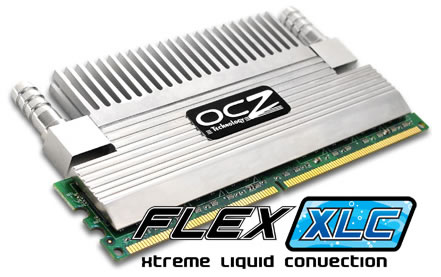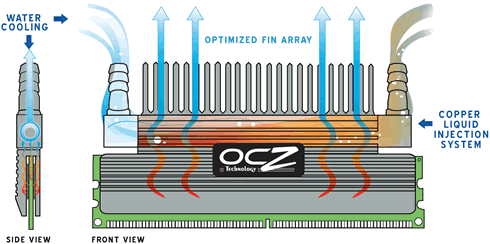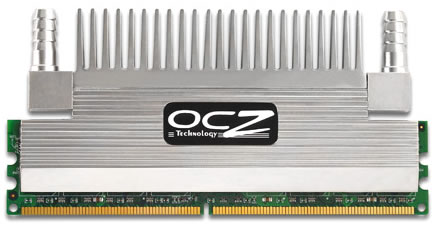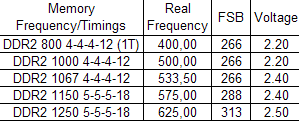1. Introduction
- Introduction
 OCZ Technology is one of the largest and best known memory manufacturers. OCZ has introduced many innovative products and recently it announced a new series of memory products with a special design, aimed mostly at overclockers and computer enthusiasts. The new design offers better heat dissipation for memory modules allowing for higher memory speeds and hence overclocking capabilities. What can you expect from the new OCZ PC2-9200 FlexXLC series?
OCZ Technology is one of the largest and best known memory manufacturers. OCZ has introduced many innovative products and recently it announced a new series of memory products with a special design, aimed mostly at overclockers and computer enthusiasts. The new design offers better heat dissipation for memory modules allowing for higher memory speeds and hence overclocking capabilities. What can you expect from the new OCZ PC2-9200 FlexXLC series?
- OCZ DDR2 PC2-9200 FlexXLC Edition
The OCZ PC2-9200 comes with the innovative FlexXLC technology, which is considerably the most ground-breaking and unique memory product existing today.
These new modules feature the new OCZ FlexXLC (Xtreme Liquid Convention) heatsink that delivers superior heat dissipation via a hybrid copper and aluminum design that allows for a choice between passive air or water cooling.

Among the thermal management advantages, the PC2-9200 FlexXLC also implements a new 8-layer PCB. This facilitates less “crosstalk,” consequently enhancing the module's total signal integrity.
The PC2-9200 FlexXLC modules are optimized for the latest cutting edge platforms and will be available in 2GB (2x1024MB) dual channel kits. As part of OCZ’s line-up of premium memory, the PC2-9200 series is backed by a Lifetime Warranty and industry-leading technical support. Harnessing the achievement of leading-edge speed, high performance heat dissipation, and enhanced signal integrity, the unparalleled design of the OCZ PC2-9200 FlexXLC is a complete, all-encompassing solution certain to set a new benchmark in enthusiast memory.
- Special features
The new OCZ FlexXLC (Xtreme Liquid Convention) heatsink delivers superior heat dissipation via the integrated hybrid copper and aluminum liquid injection system. The FlexXLC module was engineered with this unique “flexible” design to give enthusiasts the unparalleled option to run the modules passively or water cooled. The concurrent use of both technologies (water-cooling) promotes maximum heat dissipation and pushes thermal management of memory modules one step further to keep up with the ever-increasing frequency demands. FlexXLC modules seamlessly co-migrate with any system upgrade to liquid cooling.

The PC2-9200 series is engineered with an 8-layer PCB with thermally conductive power and ground planes to guide heat away from the ICs and maintain the necessary signal integrity for high-end modules.
OCZ EVP (Extended Voltage Protection) is a feature that allows performance enthusiasts to use a VDIMM of 2.35V without invalidating their OCZ Lifetime Warranty.
EPP (Enhanced Performance Profiles) setting is rated at 1142MHz
- Full specifications
- 1150MHz DDR2
- CL 5-5-5-18
- Available in 2GB (2x1024) Dual Channel Kits - OCZ2FX11502GK
- Unbuffered
- OCZ Lifetime Warranty
- 2.3 Volts
- 240 Pin DIMM
- 2 x 1/4" ID (inner diameter) barbs
2. Retail package
- Retail package
OCZ provided us with the retail package of their FlexXLC with 2 GB (2x1GB), costing around US$320 (+shipping) as found at several online stores. The kit comes in the standard packaging for OCZ memory products

It's nearly impossible to open the retail package unless you break the "security" seal. This way, you know you are buying a brand new retail product

After opening the retail package, we can better examine the modules. On the front is the OCZ Technology logo.

While on the back, the memory product number and suggested memory timings.

The two 1/4" ID (inner diameter) barbs can be used either for water or air cooling, so you can say that the modules are certified as "Water Cooling Ready":

The slim design of the heatsink/fins means there's no problem using four modules side by side for maximum memory capacity.

Removing the heatsink reveals Micron D memory chips mounted on an 8-layer PCB. OCZ claims that this design allows for higher overclocking capabilities. We will find out how much, later on in our review.
3. Testbed
In order to test the memory modules, we used the following setup:
- CPU: Intel XE6600 @ 2.4GHz
- Motherboard: eVGA 680i LT
- PSU: OCZ GameXStream GXS600 SLI-Ready
- VGA: MSI 7600GT Silent (stock memory/core timings)
- HDD: WD 800JB
- OS: Windows XP SP2 with all the latest updates installed
While for benchmarking, we used:
- Memtest86+ v1.70
- Sisoft Sandra 2007 SP1
- RightMark Memory Analyzer v3.70
- ScienceMark 2.0 Memory Benchmark
- Pov-Ray v3.70 Beta15
- SuperPI XS Mod v1.50
The eVGA 680i LT motherboard offers many possibilities of overclocking both memory and CPU, either synced or not. For most of our tests, we set the memory and CPU to un-synced and tried to find the best possible, lower memory timings. Before benchmarking, each test had to pass a 30 min burn-in test from Memtest86+ v1.70 (DOS) without producing any errors. Furthermore, we tried the Pov-Ray benchmark and Orthos Stability test under Windows to ensure that our system was rock solid. All benchmarks were run twice and all displayed results are the average of both measurements.
The SPD as reported by Everest Ultimate Edition are set only for 270MHz and 400MHz with CL4 and CL5 respectively:

The memory modules can also work at 1T with Nvidia based chipsets, for example @ 400MHz very low timings are possible, down to 4-4-4-12:

OCZ suggests the following memory timings for the different chipsets, that allow up to 1150MHz memory speed:
Detailed Settings |
i965 Chipset |
i680 Chipset |
CAS 5 |
CAS 5 |
TRDC 5 |
TRDC 5 |
TRP 5 |
TRP 5 |
TRAS 18 |
TRAS 18 |
TWR 6 |
TRRD 6 |
TRRC 42 |
TRC 33 |
TRRD 11 |
TWR 6 |
TRTR 11 |
TWTR 11 |
TRTP 11 |
TREF 3.9 |
TWTP 11 |
|
Lastly, here are the test results with FSB and used voltage. In order to get low CL4 timings at 1067MHz, we had to use 2.40V memory voltage and of course the highest DDR2 1250MHz can be achieved only with 2.50V, rather high for a memory module.

At DDR2 1250MHz, our CPU FSB and RAM were synced (1:1) and we overclocked the CPU up to 2.812GHz

Below are the memory timings as reported via CPU-Z

4. SiSOFT Sandra - RightMark
 SiSoftware Sandra (the System ANalyser, Diagnostic and Reporting Assistant) is an information & diagnostic utility. It should provide most of the information (including undocumented) you need to know about your hardware, software and other devices whether hardware or software. It works along the lines of other Windows utilities, however it tries to go beyond them and show you more of what's really going on. Giving the user the ability to draw comparisons at both a high and low-level. You can get information about the CPU, chipset, video adapter, ports, printers, sound card, memory, network, Windows internals, AGP, PCI, PCIe, ODBC Connections, USB2, 1394/Firewire, etc.
SiSoftware Sandra (the System ANalyser, Diagnostic and Reporting Assistant) is an information & diagnostic utility. It should provide most of the information (including undocumented) you need to know about your hardware, software and other devices whether hardware or software. It works along the lines of other Windows utilities, however it tries to go beyond them and show you more of what's really going on. Giving the user the ability to draw comparisons at both a high and low-level. You can get information about the CPU, chipset, video adapter, ports, printers, sound card, memory, network, Windows internals, AGP, PCI, PCIe, ODBC Connections, USB2, 1394/Firewire, etc.
Sisoft Sandra offers two tests, un-buffered and buffered. We summed the results both and divided them by 2.

 Before this test packet was created there was no proper software for measuring vital system parameters such as CPU/Chipset/RAM providing steady and reliable (reproducible) test results and allowing for changing test parameters in a wide range.
Before this test packet was created there was no proper software for measuring vital system parameters such as CPU/Chipset/RAM providing steady and reliable (reproducible) test results and allowing for changing test parameters in a wide range.
Vital low-level system characteristics include latency and real RAM bandwidth, average/minimal latency of different cache levels and its associativity, real L1-L2 cache bandwidth and TLB levels specs. Besides, these aspects are usually not paid sufficient attention in product technical documentation (CPU or chipset). Such test suite, which combines a good deal of subsets aimed at measuring objective system characteristics, is a must have for estimating crucial objective platform parameters.
RightMark offers a variety of test results, including both read/write performance from synthetic and performance tests:

5. Science Mark - SuperPi
Science Mark 2.0 is an attempt to put the truth behind benchmarking. In an attempt to model real world demands and performance, SM2 is a suite of high-performance benchmarks that realistically stress system performance without architectural bias. Science Mark 2.0 is comprised of 7 benchmarks, each of which measures a different aspect of real world system performance.

SuperPI has become a utility to benchmark modern systems. In August 1995, the calculation of pi up to 4,294,960,000 decimal digits was achieved using a supercomputer at the University of Tokyo. The program was written by D.Takahashi and he collaborated with Dr. Y.Kanada at the computer center, the University of Tokyo. This record-breaking program was ported to a personal computer environment such as Windows NT and Windows 95 and called Super PI.

The software offers up to 32M calculations of PI numbers. For all memory settings, we tested up to 2M calculations.

6. Comparison Results
- Comparison Results
In order to gauge the performance of OCZ's PC2-9200 FlexXLC, we offer the results for two other memory modules, from OCZ and Crucial, for comparison.



We can see that the OCZ PC2-9200 is faster than both the OCZ PC2-7200EPP and Crucial PC2-8000 in almost all tests except for 1000MHz speed. Top performance from OCZ PC2-9200!
7. Conclusion
- Conclusion
 The OCZ PC2-9200 comes with the FlexXLC technology, which is at least unique for a memory product in today's market.
The FlexXLC (Xtreme Liquid Convection) heatsink offers better heat dissipation via a hybrid copper and aluminum design, allowing for a choice between passive air or water cooling. Since no other product on the market offers this kind of cooling method, there's probably good market potential for such a product and OCZ.
The OCZ PC2-9200 comes with the FlexXLC technology, which is at least unique for a memory product in today's market.
The FlexXLC (Xtreme Liquid Convection) heatsink offers better heat dissipation via a hybrid copper and aluminum design, allowing for a choice between passive air or water cooling. Since no other product on the market offers this kind of cooling method, there's probably good market potential for such a product and OCZ.

According to our tests, the memory reached 625.00MHz with voltage up to 2.5V! That's 50MHz higher than what OCZ advertises for the product. This is clearly the highest memory speed we have seen in our labs. With lower speeds you can even have 1T at 400MHz while the DDR2 1000MHz (2.1~2.2V) seems the best initially for overclocking CPU. Of course, this applies only with Nvidia 680i chipsets. So, before buying this memory kit, be sure to check your motherboard memory voltages, although most currently sold boards can support up to 2.4V without any problem. There have been some reports that this memory can handle even higher voltages and reach 650MHz, but we couldn't confirm this, since our motherboard had a memory voltage ceiling of 2.50V.

Ending our presentation, we were very satisfied with the OCZ PC2-9200 FlexXLC memory series. The product does work as advertised and with the proper motherboard/memory voltage, can boost an additional 50Mhz for your overclocking needs. The retail price is considered "low" for this type of unique product. You can buy 2x1GB of OCZ PC2-9200 for around US320$ or €310.

What else can you ask from OCZ? Top performance, neat design, high overclocking capabilities and of course, the right price...